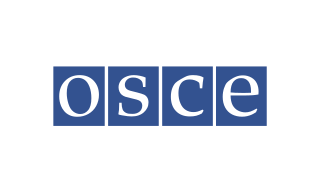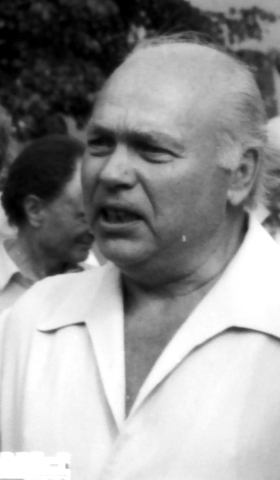Related Research Articles

The Organization for Security and Co-operation in Europe (OSCE) is a regional security-oriented intergovernmental organization comprising member states in Europe, North America, and Asia. Its mandate includes issues such as arms control, the promotion of human rights, freedom of the press, and free and fair elections. It employs around 3,460 people, mostly in its field operations but also in its secretariat in Vienna, Austria, and its institutions. It has observer status at the United Nations.

Human Rights Watch (HRW) is an international non-governmental organization headquartered in New York City that conducts research and advocacy on human rights. The group pressures governments, policymakers, companies, and individual human rights abusers to denounce abuse and respect human rights, and often works on behalf of refugees, children, migrants, and political prisoners.

The Helsinki Final Act, also known as Helsinki Accords or Helsinki Declaration was the document signed at the closing meeting of the third phase of the Conference on Security and Co-operation in Europe (CSCE) held in Helsinki, Finland, between 30 July and 1 August 1975, following two years of negotiations known as the Helsinki Process. All then-existing European countries as well as the United States and Canada, altogether 35 participating states, signed the Final Act in an attempt to improve the détente between the East and the West. The Helsinki Accords, however, were not binding as they did not have treaty status that would have to be ratified by parliaments. Sometimes the term "Helsinki pact(s)" was also used unofficially.
A dissident is a person who actively challenges an established political or religious system, doctrine, belief, policy, or institution. In a religious context, the word has been used since the 18th century, and in the political sense since the 20th century, coinciding with the rise of authoritarian governments in countries such as Fascist Italy, Nazi Germany, Imperial Japan, Francoist Spain, the Soviet Union, Saudi Arabia, North Korea, Turkey, Iran, China, and Turkmenistan. In the Western world, there are historical examples of people who have been considered and have considered themselves dissidents, such as the Dutch philosopher Baruch Spinoza. In totalitarian countries, dissidents are often incarcerated or executed without explicit political accusations, or due to infringements of the very same laws they are opposing, or because they are supporting civil liberties such as freedom of speech.
The 1977 Constitution of the Soviet Union, officially the Constitution of the Union of Soviet Socialist Republics, was the constitution of the Soviet Union adopted on 7 October 1977.

Helsinki Committees for Human Rights exist in many European countries as volunteer, non-profit organizations devoted to the protection of human rights. It was presumably named after the Helsinki Accords. It was formerly organized into the International Helsinki Federation for Human Rights (IHF), based in Vienna.
The British Helsinki Human Rights Group (BHHRG) was an Oxford-based non-governmental organization which claimed to monitor human rights in the 56 participating States of the Organization for Security and Co-operation in Europe (OSCE). Despite its name, the organisation was not affiliated to the Helsinki Committee for Human Rights. BHHRG was critical of what it characterized as Western interference in imposing democracy, and claimed to support the right of political independence from the west of a number of Communist and post-Communist regimes, as well as of a number of African dictators.
The International Helsinki Federation for Human Rights (IHF) was a self-governing group of non-governmental organizations that acted to protect human rights throughout Europe, North America and Central Asia. A specific primary goal was to monitor compliance with the human rights provisions of the Helsinki Final Act and its follow-up documents.
Robert Louis Bernstein was an American publisher and human rights activist.

The Conference on Security and Cooperation in Europe (CSCE) was a key element of the détente process during the Cold War. Although it did not have the force of a treaty, it recognized the boundaries of postwar Europe and established a mechanism for minimizing political and military tensions between East and West and improving human rights in the Communist Bloc. The first phase was the Meeting of Foreign Ministers in Helsinki in 1973, the second negotiations held in Geneva from 1973 to 1975, and the third the Helsinki summit in 1975. The final document was signed in Helsinki, Finland on August 1, 1975, by 33 European nations, the United States and Canada. It is often called the Helsinki Agreement. In 1994, the Organisation for Security and Cooperation in Europe (OSCE) was established as a successor to CSCE.
Soviet dissidents were people who disagreed with certain features of Soviet ideology or with its entirety and who were willing to speak out against them. The term dissident was used in the Soviet Union (USSR) in the period from the mid-1960s until the Fall of Communism. It was used to refer to small groups of marginalized intellectuals whose challenges, from modest to radical to the Soviet regime, met protection and encouragement from correspondents, and typically criminal prosecution or other forms of silencing by the authorities. Following the etymology of the term, a dissident is considered to "sit apart" from the regime. As dissenters began self-identifying as dissidents, the term came to refer to an individual whose non-conformism was perceived to be for the good of a society. The most influential subset of the dissidents is known as the Soviet human rights movement.

The Moscow Helsinki Group was one of Russia's leading human rights organisations. It was originally set up in 1976 to monitor Soviet compliance with the Helsinki Accords and to report to the West on Soviet human rights abuses. It had been forced out of existence in the early 1980s, but was revived in 1989 and continued to operate in Russia.
The Kharkiv Human Rights Protection Group (KhPG) is one of the oldest and most active Ukrainian human rights organizations. As a legal entity, it was established in 1992, but it has been working as a human rights protection group in the Ukrainian SSR since 1988 under the Society "Memorial". It was the first official human rights organization in the former USSR. Many members of the organization took part in a human rights movement of the 1960s – 1980s.

The Ukrainian Helsinki Group was founded on November 9, 1976, as the "Ukrainian Public Group to Promote the Implementation of the Helsinki Accords on Human Rights" to monitor human rights in Ukraine. The group was active until 1981 when all members were jailed.
The Norwegian Helsinki Committee is a Norwegian human rights non-governmental organization based in Oslo. It was founded in 1977 following the adoption of the Helsinki Accords. It works to ensure that human rights are respected in practice. It was affiliated with the now defunct International Helsinki Federation for Human Rights.
The Palestinian Centre for Human Rights is a Palestinian human rights organization based in Gaza City. It was founded in 1995 by Raji Sourani, who is its director. It was established by a group of Palestinian lawyers and human rights activists and receives funding from governmental, non-governmental, and religious sources.
The Czech Helsinki Committee is a non-governmental non-profit organization for human rights. It has operated in Czechoslovakia since 1988 and in the Czech Republic since 1993. It was founded as one of the first "Helsinki" organizations outside of the USSR, and is the first formalized human rights NGO in the country.
The Lithuanian Helsinki Group was a dissident organization active in the Lithuanian SSR, one of the republics of the Soviet Union, in 1975–83. Established to monitor the implementation of the Final Act of the Conference on Security and Cooperation in Europe, better known as Helsinki Accords, it was the first human rights organization in Lithuania. The group published over 30 documents that exposed religious repressions, limitations on freedom of movement, political abuse of psychiatry, discrimination of minorities, persecution of human right activists, and other violations of human rights in the Soviet Union. Most of the documents reached the West and were published by other human rights groups. Members of the group were persecuted by the Soviet authorities. Its activities diminished after it lost members due to deaths, emigration, or imprisonment, though it was never formally disbanded. Some of the group's functions were taken over by the Catholic Committee for the Defense of the Rights of Believers, founded by five priests in 1978. Upon his release from prison, Viktoras Petkus reestablished the Lithuanian Helsinki Group in 1988.

Viktoras Petkus was a Lithuanian political activist and Soviet dissident. He was a founding member of the Lithuanian Helsinki Group in 1976 which set out to document violations of human rights in the Soviet Union. For various anti-Soviet activities, Petkus was imprisoned three times in various prisons and Gulag camps by the Soviet authorities.
In 1965 a human rights movement emerged in the USSR. Those actively involved did not share a single set of beliefs. Many wanted a variety of civil rights — freedom of expression, of religious belief, of national self-determination. To some it was crucial to provide a truthful record of what was happening in the country, not the heavily censored version provided in official media outlets. Others still were "reform Communists" who thought it possible to change the Soviet system for the better.
References
- ↑ Bernstein, Robert L. (October 19, 2009). "Opinion - Rights Watchdog, Lost in the Mideast". New York Times . Retrieved May 1, 2018.
- ↑ "Our History". Human Rights Watch. September 24, 2008. Retrieved July 18, 2019.
- ↑ "Human Rights Watch Archives | Columbia University Libraries". library.columbia.edu. Retrieved May 29, 2019.
- 1 2 3 4 5 "Our History". hrw.org. September 24, 2008. Retrieved May 1, 2018.
- 1 2 3 4 Whiteclay, C. I. (2004). The Oxford Companion to American Military History. Oxford: Oxford University Press. doi:9780195071986
- ↑ Langley, W. (1999). Encyclopedia of human rights issues since 1945. London: Fitzroy Dearborn.
- ↑ Iriye, A., Goedde, P., & Hitchcock, W. I. (2012). The human rights revolution: An international history. Oxford: Oxford University Press.
- ↑ "Home". Ford Foundation. Retrieved May 1, 2018.
- ↑ Marchetti, R. (2017). Partnerships in international policy-making: Civil society and public institutions in European and global affairs. London: Palgrave Macmillan
- 1 2 Thomas, D. C. (2011). The Helsinki effect: International norms, human rights, and the demise of communism. Princeton (N.J.: Princeton University Press.
- ↑ Fahlenbrach, K. (2012). The establishment responds: Power, politics, and protest since 1945. New York: Palgrave Macmillan.
- ↑ "The Helsinki Process and the Fall of Communist Regimes in Europe". Tavaana. Retrieved May 1, 2018.
- ↑ "From Helsinki to Human Rights Watch: How an American Cold War Monitoring Group Became an International Human Rights Institution". Humanity Journal. December 16, 2014. Retrieved July 18, 2019.
- ↑ Bob, C. (2011). The International Struggle for New Human Rights. (Rights, Action, and Social Responsibility.
- ↑ Falgiano, L., & LeMaire, K. (November 1992). "Review: Helsinki Watch publications". Human Rights Quarterly, 14(4), 640-645. doi : 10.2307/762336. JSTOR 762336.